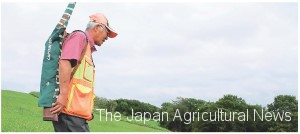Unidentified brown bear “OSO18” attacking milk cows in eastern Hokkaido, threatening dairy farmers
An area in eastern Hokkaido with a thriving dairy industry has recently been suffering from damage caused by an unidentified giant brown bear attacking milk cows and ruining crops of corn for feed.
Local hunters are making every effort to hunt the bear, but they have not been able to capture the animal.
There had not been any cases in the past of brown bears attacking livestock, but since 2019, attacks on milk cows leading to injuries and deaths have been reported every year.
Dairy farmers are forced to continue business with feelings of fear amid the abnormal situation.
The unidentified bear is given a code name OSO18, deriving from Osotsubetsu, a district in the town of Shibecha where damages were reported, and the fact that a footprint left at the site of damage was 18 centimeters wide.
The average weight of a male brown bear is roughly 200 kilograms, but OSO18 is estimated to weigh between 300-400 kg.
It apparently has incredible strength as it has attacked a milk cow weighing nearly 200 kg.
In the towns of Shibecha and Akkeshi in eastern Hokkaido, Japan’s leading dairy farming region, it is believed that OSO18 attacked a total of 64 milk cows between fiscal 2019 when damage was first reported and Aug. 19.
An official of the Hokkaido Government’s Kushiro General Subprefectural Bureau said, “No one has ever directly witnessed (the bear) and everything is within the realm of imagination. We can only estimate its size and such.”
The milk cows had big scratches on their back, which seem to have been made by thick claws, and big footprints were left at the sites, suggesting that they were attacked by OSO18.
Local hunters, agricultural cooperatives and authorities are desperately trying to capture the bear in order to protect the dairy farms, but they have not been successful for more than three years.
They are at least beginning to grasp the animal’s movement history by analyzing surveillance camera footage and conducting DNA testing of feces and body hair found near the footprints.
Every time an attack on a milk cow occurred, Isao Goto, 78, a resident of Shibecha who heads the local hunters’ association, went to keep an eye out around pastures with 10 hunters all day long from sunrise to sunset.
They did so because there was a possibility that OSO18 would come back to approach the milk cow it attacked.
Even if the attacked milk cow died, the hunters did not carry the body away immediately and waited in ambush even in scorching heat or below freezing temperature. But the bear never appeared.
Recently, there was even a case in which a cow had been attacked close to a cowshed.
Goto, with 60 years of experience as a hunter, has captured more than 10 brown bears so far, but there had not been any attacks on milk cows until recently.
Increasing cases of damage to crops of corn for feed, believed to be caused by brown bears other than OSO18, are also reported.
“Yezo sika deer are increasing sharply in the neighborhood, and brown bears no longer hibernate because they can feed on Yezo sika deer during winter,” Goto said, speculating on the reasons for the recent situation. “The changes in the global environment are leading to agricultural damage caused by brown bears.”
Still, Goto says he will not give up.
“This town relies on dairy farming. I want to do something to help dairy farmers get out of difficulty, as they hesitate to expand cultivation of corn for feed thinking the crops are inducing (damage),” he said.
“We are gradually grasping (the animal’s) behavioral characteristics and patterns. We want to capture it somehow for the sake of dairy farmers and local agriculture,” he added.
Local governments and local farm coops whose members reported damage – JA Shibecha and JA Kushiro Ota – are taking various measures with the help of experts.
JA Shibecha is supporting hunters by providing subsidies for summer hunting clothes and box traps. It also flies drones to grasp the damage caused by wildlife on corn crops.
Nearly 20 farms in the area covered by JA Shibecha confirmed damage on their corn crops in the last fiscal year.
JA Kushiro Ota also plans to introduce box traps for capturing bears and drones for taking aerial shots of damage on crops.
Arrangements are made for JA Kushiro Ota officials to report immediately when they receive information of damage from farmers.
Source: http://english.agrinews.co.jp/?p=10225

